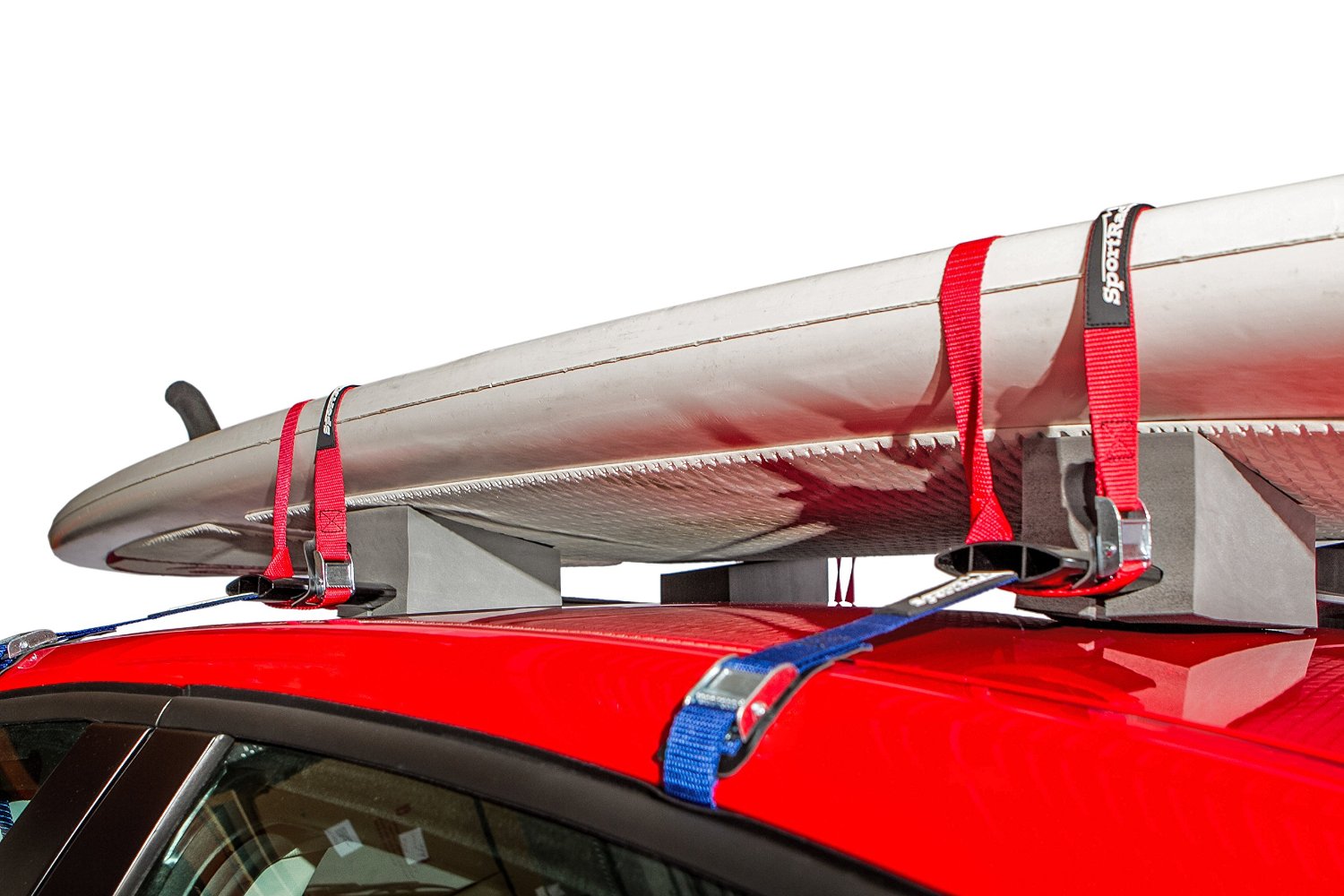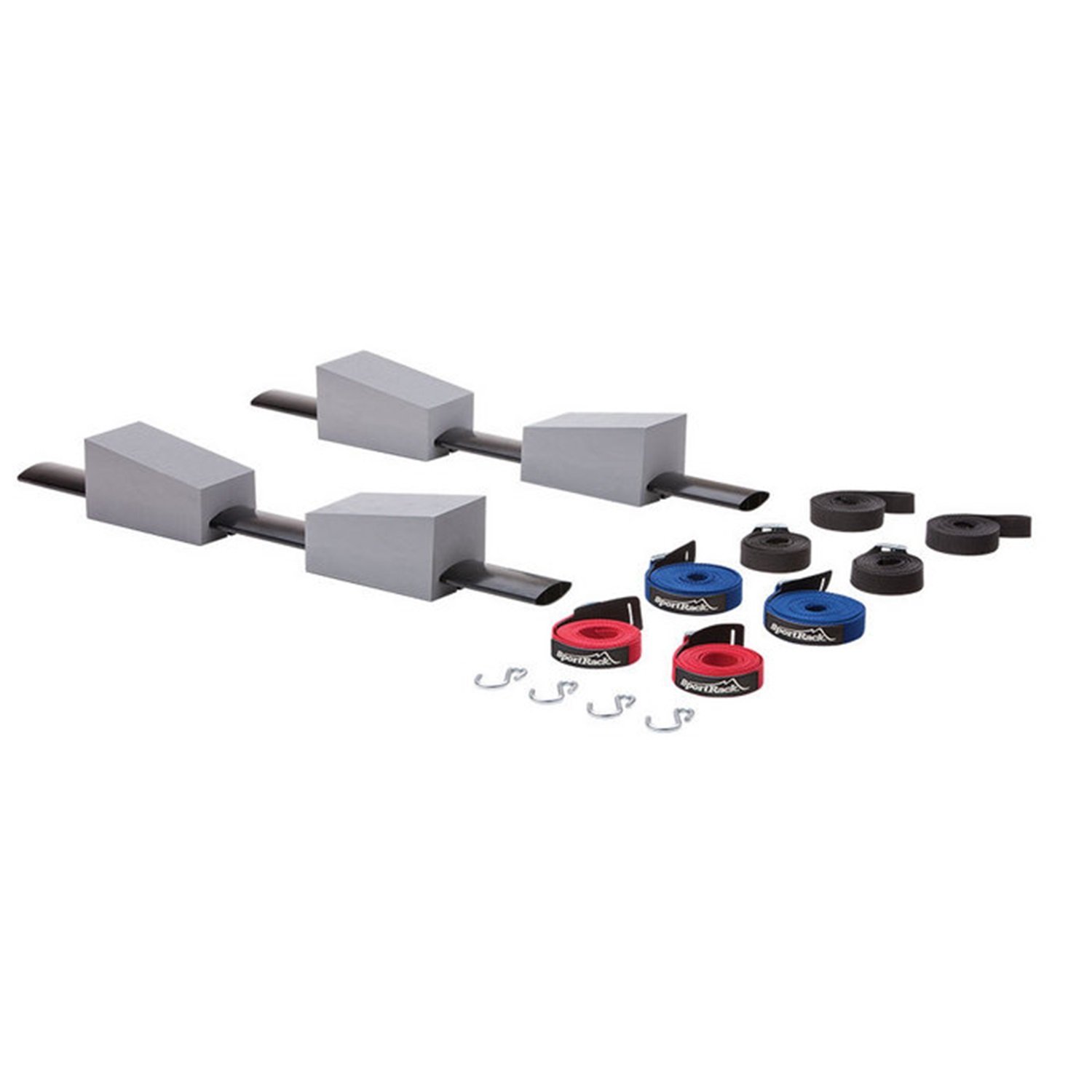
If you’re heading out on a paddling trip, we recommend using a roof rack. Why? Because you don’t want to be like me and duct tape pool noodles to your old aluminum boat and tie it onto your compact car with hemp rope. It’s not going to end well.
Let’s find out why roof racks are a life saver, and how you can find the best kayak roof rack to suit your needs!
Best Roof Racks for Kayaks
Product | Type | Price | Our Rating |
|---|---|---|---|
Foam Carrier | $ | ||
Cross Rail | $$$ | ||
Cross Rail | $ | ||
Cross Rail | $$ | ||
Cross Rail | $$$ | ||
Kayak Carrier | $ | ||
Kayak Carrier | $$$ | ||
Kayak Carrier | $$$ |
Scroll down to see full reviews!
Roof Racks vs Foam Carriers
If you’re lucky enough to be rolling around in an SUV or outdoor/off-road vehicle, then you may already have roof rails in place. This will make it easy to grab a dedicated roof rack to fit your vehicle model.
However, many vehicles have no rails or racks at all on top. But fear not, you won’t have to give up kayaking. There are still ways to secure a boat to your roof without scratching your car or breaking a window.
Foam Carriers

For those cars without a dedicated roof bar system, these hard, dense foam adapters are my favorite solution. I used one myself for years!
One of the best features is the super low price – often less than $30 for a foam kayak carrying roof solution.
They’re simple to use, with only a couple straps and a foam block. They’re also made out of totally weather proof material and will last for years. Can’t go wrong here!
Most foam roof adapters are universal, but still take a look at your kayak and see if you have a v-shaped hull or rounded hull and purchase accordingly.
The only downside (and I'm being super picky here) is that foam carriers aren't really a permanent rack solution and you will have to install them each time you want to transport your yak. Installation is easy enough, but can be a mild inconvenience.
Roof Racks
If you’re lucky enough to have rails on top of the ol’ Subaru, then a dedicated roof rack will be a sweet and simple solution to your carrying needs.
Bonus? It’s pretty easy to find custom carrying solutions to satisfy all your weekend warrior pursuits. Roof rack accessories make it easy to carry multiple kayaks, your bike, and camping gear... all at the same time.
These racks also have the advantage of being able to be left securely mounted in place when the kayak isn’t on top, so it’s a bit of a set and forget system.
Disadvantage? You might rip the top of your car off if you leave the roof rack system in place and pull in somewhere with very low ceiling clearance or low hanging objects. Major bummer. They’re also a lot pricier than foam adapters.
Raingutter Systems
The rain gutter is a piece of metal which sticks out around the top edge of your doors to deflect rain and water. This gives an attachment point for many systems.
Many of the most successful aftermarket roof rails (and some foam block adapters) are made to strap and secure to the rain gutters. Many vehicles, however, do not have a rain gutter.
Can I Add Rails to My Car?
So you picked up the lame-mobile and it doesn’t have rails built into the roof. Better grab a foam adapter or… oh wait… maybe not!
If you’re a DIYer with steady hands and some gumption, it’s possible to add your own roof rails with permanent fixture!
Not in to the idea of drilling holes in your car roof? That’s okay because many vehicles have aftermarket rails that can be fitted without any permanent modification.
We’re pretty sure most of you aren’t going to want to spend your Saturday drilling holes in the car roof, so it may be best to stick with non-permanent aftermarket systems. Suction cups and strapping can offer comparable capacity to fitted rack systems, so there really is no need to risk it.
Do Roof Racks Need Special Skills to Install or Use?
Nope. No mechanical knowledge or special skills necessary.
If you have the most basic of DIY skills, you could install your own roof rack adapters. Or you could leave it to the pros – almost all suppliers will install them for you for a small fee.
Loading and unloading takes some time to perfect, but we’re certain you’ll get the hang of it. Recruit the kids, neighbors, or nearby hikers to give you a hand.
What does take special skills is repainting the car or fixing a broken window if you don’t use the right roof rack! So, two lessons here: ask for help, and don’t skimp on a good roof rack.
How to Transport More Than One Kayak
Most vehicles will be wide enough to transport a couple of yaks, and you may even be able to get three or more kayaks on top with some clever positioning and careful strapping.
What about trailers or side mounts? Yes… there are a few examples of kayaks mounting to the side of vehicles, and if you REALLY need extra space, this might work for you. However, we’re pretty sure a trailer would be a more reasonable solution.
Single and double kayak trailers will solve your problem and, when paired with a roof system, you could get as many as four kayaks per vehicle.
How to Find the Right System
As we mentioned before, if you’re not sure it might be best to contact the manufacturer of aftermarket rail systems and tell them exactly what car you have to avoid confusion.

J-style carriers on cross rails are a perfect solution for most kayaks. Image Flick / Michael (a.k.a. moik)
Another suggestion is to head to your local auto accessories specialty shop and ask them what they can do for you. These stores specialize in this process and can take care of the guess work for you!
If you tell them what you’re into (kayaking, cycling, etc), they’ll be able to kit you out with a base rack system that can be accessorized to suit all your needs.
Thule and Yakima are leaders in this space, but their products can be more expensive than comparable, lesser-known rack manufacturers. If you’re not willing to shell out several hundred dollars, our product round-up below has a solution for every budget.
What’s the Best Way to Use a Kayak Roof Rack?
If you’re using a foam pad adapter, then it’s super simple and straightforward:
- Place foam pads on roof
- Attach any necessary straps
- Get someone to help you put the kayak on the foam pads (avoid scratches!)
- Securely strap the kayak from both sides and front to back. Securing the kayak to the vehicle at the bow in stern to prevent uplift is very important.
- Use tie down straps or learn the trucker’s hitch knot
Easy!
For a roof rail permanent mounting system, you’ll want to follow these steps:
- Follow instructions to install kayak rack on to roof rails
- Toss your kayak(s) on the racks
- Use ratchet straps, tie downs, or the truckers hitch to secure those kayaks!
- Don’t forget to double check the security of the kayaks after each stop on your trip
- Keep in mind roof racks often add extra height – don’t hit the garage door!
Buying Guide: Our Pick of the Best Kayak Roof Racks
So now you know what to look for, we’ve rounded up what we think are the safest and most reliable solutions for transporting your kayak. We’ve included options for those with vehicles with rails and for those without, so you’ll be sure to find the perfect match.
You can either go with a foam carrier system, or choose to match a cross rail with a dedicated kayak carrier.
Foam Carriers
SPORTRACK 24 inch Adjustable Kayak Carrier

If you’ve not got rails or don’t want a permanent rack in place, the 24-inch foam carrier from Sportrack is a near perfect solution. The system securely fastens you yak to the roof, and thanks to the non-skid material used, the blocks won’t leave any marks once removed.
The foam block spacing can be adjusted (from 16”–24”) to fit most kayaks and canoes. The blocks also secure to the roof, so they won’t move as you lift and slide your kayak into the cradles.
Foam blocks are usually only intended for short distance travel, but we reckon you’d have no problems with long distance kayak transport with the Sportrack Carrier.
The only downside is that you have to have four doors.
The whole package comes with straps to fasten your kayak to the blocks and loop through the vehicle doors, and bow and stern tie down ropes to prevent uplift.
Cross Rails
Thule Aeroblade Bars

From a well-known brand, these aftermarket roof rail bars attach to a wide range of vehicles. We recommend contacting the manufacturer to confirm they’ll work for your year and model before purchasing.
The Aeroblade cross bars come in lengths of 43”, 47”, 53”, and 60”, so you’ll be able to find a length that is in proportion to the width of your vehicle and will carry everything you need.
The aerodynamic design of the cross rail ensures whisper quietness inside the cabin. And being a Thule product, you have a wide range of accessories available to attach to the rails including cargo boxes, baskets, bike carriers, and kayak carriers.
These are perfect for cars without roof rails and people seeking a flexible mounting system from an industry powerhouse. I’ve used Thule racks for years and can’t think of anything critical to say about their products!
CargoLoc Roof Top

These rails raise the bar (literally) and mount to existing roof rack systems. If your car is equipped with side rails but no cross rail system, this is the ideal solution! The only drawback is that you must already have roof rails on your car.
They look great, with a stylish aluminum finish, but are also built to last, with a top rating of 150 lbs and anti-scratch strips which protect your cargo and the rack. The included hex wrench makes installing the rails a piece of cake.
The 52” aluminum bars are sturdy and wide enough to transport most loads easily.
The stand-out attraction of the CargoLoc bars is the phenomenal value they represent. They offer a low-cost transport solution that can be purchased for only a little more than a foam carrier. Ideal if you don’t want to splash several hundred dollars on a Thule or Yakima rack setup.
Nothing overly fancy here, just practical function.
Malone VersaRail Universal Cross Bars

No roof rails? No problem! Suction cups and nylon/polyester straps make this roof rack suitable for any vehicle (there is also a roof rail option).
The suction cups are surprisingly effective, and the rack system is rated to 135 lbs. But don’t forget to double check the secure fastening of the rack every time you stop for gas… you know, just in case…
The rail comes in 50” and 58” lengths and the suction cup spacing is adjustable. With a couple of easy tweaks, you can make this rack fit almost any vehicle. We can’t say it’ll fit your car for sure, but chances are… it will!
1.25 x 0.9 inch bars are a good section size for strength, but still trim enough that most rack accessories will fit the bars.
No additional tools are required to install the Versarail cross bars, and installation is super easy.
Durability is not a concern. The coated steel bars are rust-resistant, and the towers that hold the bar are scratch resistant. Plus, the whole setup comes with a lifetime warranty. Not that you’re likely to need it, as Malone make high-quality products and are a trusted player in this space.
Malone AirFlow Universal Cross Rail System

If you’ve already got a roof rail mounting system on the vehicle but no cross bars, this is your tool.
The Malone Airflow is highly adjustable and will provide a cross rail solution for almost any vehicle already equipped with side rails. Note: this rack also comes in a no roof rail model.
The sleek design looks stylish and cuts through wind with minimal resistance and noise.
However, the rails not only look good, but are also built to last. The double-walled aluminum rails are tough as nails and safe to load up to a maximum of 165 pounds. And being a Malone product, you have full integration with their extensive selection of carriers.
Tool-free installation is a bonus for the DIY adverse kayaker.
Kayak Carriers
TMS J-Bar HD Kayak Carrier

A great budget-minded solution for rail systems, this kayak carrier can be bought in two pairs to carry up to two kayaks per vehicle!
A low price and nearly universal fitment make this an excellent entry level choice. The kayak carrier also comes with the straps you’ll need to secure your boat.
And although the TMS J-bar rack is a thrifty choice, TMS haven’t skimped on quality, with the carrier featuring a rugged steel frame design capable of supporting up to 75 lbs comfortably.
All in all, we think this a good solution for the economy-focused paddler! If you’re just getting started kayaking and don’t know how dedicated you are to the sport, this might be a good choice to start out.
Malone Downloader Folding J-Style Kayak Rack

More expensive than our first contestant, this rack has a serious bonus feature we think is worth the money: the ability to fold! There is nothing more annoying than having to mount and unmount your roof rack – trust me!
Mount this roof rack system once and when not in use, simply fold it down for better gas mileage, less road noise, and easy access to your garage.
Through efficient design, Malone has produced a top product that overcomes a common roof rack problem: overhead clearance. We think it’s worth paying the little bit extra for such a handy feature.
The carriers come with straps and all accessories required to safely transport your kayak.
Malone SeaWing Saddle Kayak Rack

Another sweet low-profile solution for a roof rack. This one, again, mounts to an existing roof rail system but instead of being vertically oriented, the kayak sits flat. This works for two sea kayaks side by side, but boats with wider hulls may have trouble fitting together on one roof.
The saddles are a good fit for touring kayaks. The little bit of flex they have tightly hugs the body of these slimmer yaks creating a more aerodynamic fit. However, if you’ve got a wider, flatter kayak, you would be better off with a J style rack.
It’s nice to have a low profile solution, but make sure it fits your needs. A vertical system is often a more versatile system for a double kayak carry.
Conclusion
If you don’t have roof rails, consider adding some yourself or getting them installed. There are plenty of solutions!
Don’t want to spend the money? No worries! Foam pad adapters are a cheap and effective solution that will get the job done. I used them for years myself without any problems.
If you’ve got roof rails already installed, I would be leaning towards a cool kayak carrier system and, honestly, we think the Malone Downloader speaks for its self in this category. Decision made!
(Main Image: Flickr / namztis)
As an Amazon Associate, we earn from qualifying purchases. This is without any additional costs for the buyer but does support us in maintaining our website.



